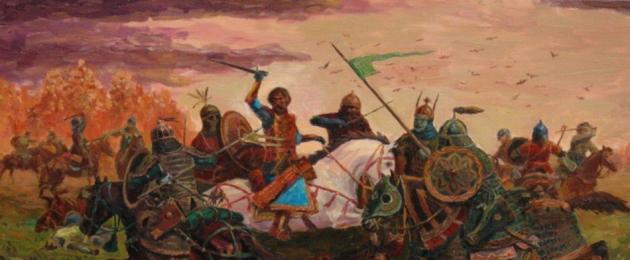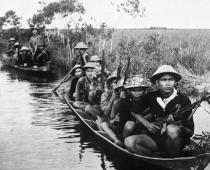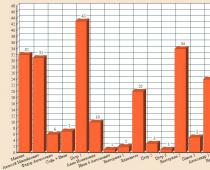Name: Batu (Batu)
Years of life: around 1209 - 1255/1256
State: Golden Horde
Field of activity: Army, politics
Greatest Achievement: Became the ruler of the Golden Horde. Spent a number of conquests in the north-west, including Russia.
Batu Khan (ca. 1205-1255) was a Mongol ruler and founder of the Blue Horde. Batu was the son of Jochi and the grandson of Genghis Khan. His (or the Kipchak Khanate), which ruled Russia and the Caucasus for about 250 years, after it destroyed the armies of Poland and Hungary. Batu was the figurehead of the Mongol invasion of Europe, while his general Subedei is credited with the glory of an excellent strategist. After gaining control of Russia, Volga Bulgaria and Crimea, he invaded Europe, winning the Battle of Mohi against the Hungarian army on April 11, 1241. In 1246 he returned to Mongolia to elect a new Great Khan, apparently hoping for supremacy. When his rival, Guyuk Khan became the Great Khan, he returned to his khanate and built the capital on the Volga - Sarai, known as Sarai-Batu, which remained the capital of the Golden Horde until it collapsed.
The role of Batu Khan in Russian and European campaigns is sometimes downplayed, giving the leading role to his general. Nevertheless, the merit of Batu is that he heeded the advice of his general to gain experience in military affairs. Perhaps the most important result of Batu Khan's Mongol invasion of Europe was that it helped draw Europe's attention to the world beyond.
As long as the Mongol Empire existed, which gave the development of trade, as well as diplomacy: for example, the papal nuncio was able to arrive at the assembly of 1246. To some extent, the Mongol Empire and the Mongol invasion of Europe, for which Batu Khan was at least nominally responsible, served as a bridge between different cultural parts of the world.
Pedigree of Batu
Although Genghis Khan recognized Jochi as his son, his origins remain in question, as his mother Borte, Genghis Khan's wife, was taken captive and he was born shortly after her return. While Genghis Khan was alive, this situation was known to everyone, but it was not discussed publicly. However, she drove a wedge between Jochi and his father; shortly before his death, Jochi almost fought with him because of the stubborn refusal of his wife, Yuki, to join military campaigns.
Jochi was also given only 4,000 Mongol soldiers to establish his own khanate. Juchi's son Batu (Batu), described as "the second and most able son of Yuki", obtained most of his soldiers by recruiting them among the conquered Turkic peoples, mainly from the Kipchak Turks. Later, Batu played an important role in swaying his uncle Udegei to the side of Tolui, his other uncle. After Jochi and Genghis Khan died, Jochi's lands were divided between Batu and his older brother Horde. The Horde ruled the lands roughly between the Volga and Lake Balkhash - the White Horde, and Batu ruled the lands west of the Volga - the Golden Horde.
After the death of Batu's heir, Sartak, Batu's brother Berke inherited the Golden Horde. Berke was unwilling to unite with his cousins in the Mongol family, going to war with Hulagu Khan, although he officially recognized only the Khanate of China as his theoretical overlord. In fact, by that time, Berke was an independent ruler. Fortunately for Europe, Berke did not share Batu's interest in conquering it, but he demanded the extradition of the Hungarian king Bela IV and sent his general Boroldai to Lithuania and Poland. Batu had at least four children: Sartak, Khan of the Golden Horde from 1255-1256, Tukan, Abukan, Ulagchi (probably the son of Sartak). Batu's mother Yuka-fuj-khatun belonged to the Mongol clan Kungirat, and his chief khatun Borakchin was an Alchi-Tatar.
Early years of Batu
After Jochi's death, his territory was divided among his sons; The Horde received the right bank of the Syr Darya and the areas around Sari Bu, Batu, the northern coast of the Caspian Sea to the Ural River.
In 1229, Ogedei sent three tumens under Kuhdey and Sunday against the tribes in the lower Urals. Batu then joined Ögedei's military campaign in the Jin Dynasty in Northern China as they fought the Bashkirs, Cumans, Bulgars and Alans. Despite the strong resistance of their enemies, the Mongols conquered many cities of the Jurchens and turned the Bashkirs into their allies.
Batu's invasion of Russia
In 1235, Batu, who had previously led the conquest of the Crimea, was assigned an army, perhaps 130,000, to oversee the invasion of Europe. His relatives and cousins Guyuk, Buri, Mongke, Khulgen, Kadan, Baydar, and the famous Mongol generals Subutai (Subedei), Borodal (Boroldai) and Mengyuser (Mnkhsar) joined him on the orders of their uncle Ogedei. The army, actually under the command of Subedei, crossed the Volga and invaded Volga Bulgaria in 1236. It took them a year to crush the resistance of the Volga Bulgars, Kypchaks and Alans.
In November 1237, Batu Khan sent his ambassadors to the Ryazan prince Yuri Igorevich and demanded his loyalty. A month later, the hordes laid siege to Ryazan. After six days of bloody battle, the city was completely destroyed. Excited by the news, Yuri sent his sons to delay the Horde, but was defeated. After Kolomna and Moscow were burned, then on February 4, 1238, the Horde laid siege to Vladimir. Three days later, the capital of the Vladimir-Suzdal principality was taken and burned to the ground. The princely family perished in the fire, and the prince himself hastily retreated to the north. Having crossed the Volga, he gathered a new army, which on March 4 on the Sit River was completely destroyed by the Mongols.
Subsequently, Batu divided his army into several parts, which devastated fourteen more cities of Russia: Rostov, Uglich, Yaroslavl, Kostroma, Kashin, Kshnyatin, Gorodets, Galich, Pereslavl-Zalessky, Yuryev-Polsky, Dmitrov, Volokolamsk, Tver and Torzhok. The city of Kozelsk, where the young Vasily reigned, turned out to be the most difficult - the inhabitants resisted the Mongols for seven weeks. Only three large cities escaped destruction: Smolensk, which submitted to the Mongols and agreed to pay tribute, and Novgorod and Pskov, which were too far away, and besides, winter had begun.
In the summer of 1238, Batu Khan devastated the Crimea and conquered Mordovia. In the winter of 1239 he took Chernigov and Pereyaslav. After several months of siege, in December 1239 the Horde broke into Kyiv. Despite the fierce resistance of Danila Galitsky, Batu managed to take the two main capitals - Galich and Vladimir-Volynsky. The states of Russia became vassals, and did not enter the Central Asian empire.
Batu decided to go to central Europe. Some modern historians believe that Batu was primarily concerned with ensuring that his flanks were protected from a possible attack from the Europeans and partly ensured further conquests. Most believe that he intended to conquer all of Europe as soon as his flanks were strengthened and his army was ready again. He probably planned a trip to Hungary, because the Russian princes and commoners took refuge there and could pose a threat.
The Mongols invaded Central Europe in three groups. One group conquered Poland, defeating the combined army under the command of Henry the Pious, Duke of Silesia and Grand Master of the Teutonic Order at Legnica. The second crossed the Carpathians, and the third came out for the Danube. The armies rejoined and defeated Hungary in 1241, defeating an army led by King Béla IV at the Battle of Mohi on 11 April. The troops swept across the Hungarian plain in the summer, and in the spring of 1242 they extended their control to Austria and Dalmatia, and also invaded Bohemia.
This attack on Europe was planned and carried out by Subedei, under the nominal command of Batu. During his campaign in Central Europe, Batu wrote to Frederick II, Holy Roman Emperor, demanding his surrender. The latter replied that he knew bird hunting well and would like to become the guardian of Batu's eagle if he ever lost his throne. The Emperor and Pope Gregory IX called for a crusade against the Mongol Empire.
Subedei achieved perhaps his most enduring glory with victories in Europe and Eastern Persia. Ruining many Russian principalities, he sent spies to Poland, Hungary and Austria, preparing to attack the central part of Europe. Having a clear picture of the European kingdoms, he prepared an attack with two "princes of the blood" (distant offspring of the Genghis Khan family), Kaidu and Kadan, although General Subedei was again the actual commander on the field. While in the north Kaidu won the Battle of Legnica and Kadan's army was victorious in Transylvania, Subedei was waiting for them on the Hungarian plain. The reunited army withdrew to the Sajo River, where they defeated King Bela IV at the Battle of Mohi.
By the end of 1241, when Batu and Subedei had completed their invasions of Austria, Italy, and Germany, news of the death of Ogedei Khan (died December 1241) overtook them, and the Mongols left in late spring 1242, as the "princes of blood" and Subedei were recalled to Karakorum, where a kurultai (congress of the Mongol nobility) was held. Batu was not actually present at the kurultai; he learned that Guyuk received enough support to become khan and stay out of the way. Instead, he turned around to consolidate his conquests in Asia and the Urals. Subedei was not with him - he remained in Mongolia, where he died in 1248, and the enmity between Batu and Guyuk Khan made further European invasion impossible.
 The beginning of the enmity dates back to 1240: celebrating the victory over Russia, Batu declared that the winner has the right to be the first to drink from the ceremonial goblet. But his cousin, apparently, believed that this right belonged to General Batu. The deterioration of relations between the grandchildren of Genghis Khan eventually led to the collapse of the Mongol Empire.
The beginning of the enmity dates back to 1240: celebrating the victory over Russia, Batu declared that the winner has the right to be the first to drink from the ceremonial goblet. But his cousin, apparently, believed that this right belonged to General Batu. The deterioration of relations between the grandchildren of Genghis Khan eventually led to the collapse of the Mongol Empire.
After the return of Batu Khan, he founded the capital of his khanate in Saray in the lower reaches of the Volga. He planned new campaigns after Guyuk's death, intending to take advantage of Subedei's original plans to invade Europe, but died in 1255. The heir was his son Sartak, who decided not to invade Europe. It is believed that if the Mongols had continued their campaign, they would have reached the Atlantic, since "no European army could have resisted the victorious Mongols."
The Kipchak Khanate ruled Russia through local princes for the next 230 years.
 The Kipchak Khanate was known in Russia and in Europe as the Golden Horde. Some people think that it is named so because of the golden color of the khan's tent. "Horde" comes from the Mongolian word "horde" (horde) or camp. The word "gold" is believed to have also meant "royal". Of all the khanates, the Golden Horde ruled the longest. After the fall of the Yuan dynasty in China and the fall of the Ilkhanate in the Middle East, the descendants of Batu Khan continued to rule the Russian steppes.
The Kipchak Khanate was known in Russia and in Europe as the Golden Horde. Some people think that it is named so because of the golden color of the khan's tent. "Horde" comes from the Mongolian word "horde" (horde) or camp. The word "gold" is believed to have also meant "royal". Of all the khanates, the Golden Horde ruled the longest. After the fall of the Yuan dynasty in China and the fall of the Ilkhanate in the Middle East, the descendants of Batu Khan continued to rule the Russian steppes.
Although Subedei is described as the real mastermind behind Batu's campaigns: "It is possible that Batu was only the supreme commander, using his name, and that the real command was in Subedei's hands." But Batu was wise enough to "skillfully use the strife between the various kingdoms of Europe" for the purposes of the Mongol campaign. And the indisputable merit of Batu was that he listened to the advice of his general and skillfully used his many years of experience in this area.
Perhaps the most significant legacy of Batu and the Mongol invasion of Europe was that it helped draw Europe's attention to the world beyond its borders, especially China, which was effectively made available for trade as the Mongol Empire itself was held together by the Silk Road and carefully guarded his. To some extent, the Mongol Empire and the Mongol invasion of Europe served as a bridge between different cultural worlds.
- In contact with 0
- Google+ 0
- OK 0
- Facebook 0








